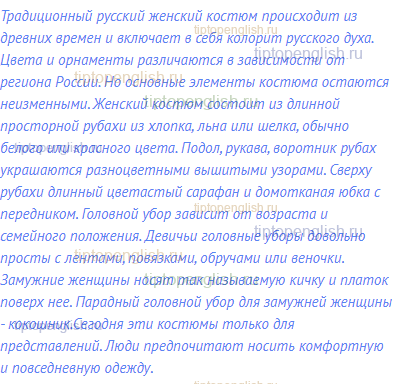ГДЗ Английский язык за 8 класс Ваулина - Spotlight - УчебникModule 4 – Culture Corner – 5
Project: Work in groups. Collect information, then write a short paragraph about a traditional costume in your country. Illustrate it with drawings or pictures. Write:
Traditional Russian women's costume comes from ancient times and includes the colorit of the Russian spirit. Colors and ornaments vary depending on the region of Russia. But the basic elements of the costume remain unchanged. Women's costume consists of a long, loose shirt made of cotton, linen or silk, usually white or red. The hem, sleeves, collar of shirts are decorated with multi-colored embroidered patterns. On top of the shirt there is a long colorful sundress and a homespun skirt with an apron. The headdress depends on age and marital status. Girly headdresses are pretty simple with ribbons, headbands, hoops, or wreaths. Married women wear a so-called kitsch and a headscarf over it. A ceremonial headdress for a married woman is a kokoshnik. Nowadays these costumes are just for performance. People prefer to wear comfortable and casual clothes.
ГДЗ - "Spotlight - Учебник"
по предмету Английский язык за 8 класс.
Год издания
2019
Aвторы
Дули Д., Эванс В., Подоляко О.Е., Ваулина Ю.Е.
Задание
Project: Work in groups. Collect information, then write a short paragraph about a traditional costume in your country. Illustrate it with drawings or pictures. Write: Проект: Поработайте в группах. Соберите информацию, затем напишите короткий абзац о традиционном костюме вашей страны. Проиллюстрируйте рисунком или фотографией. Напишите: • what material it is made of из какого материала сделан; • what it consists of из чего состоит; • its origins его происхождение; • where/when people wear it nowadays где/конда люди носят его сегодня.





